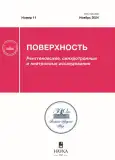Методы повышения эффективности процесса электроформовки открытых “сэндвич”-структур металл–диэлектрик–металл
- Авторы: Мордвинцев В.М.1, Горлачев Е.С.1, Кудрявцев С.Е.1
-
Учреждения:
- Ярославский филиал Физико-технологического института им. К.А. Валиева РАН
- Выпуск: № 11 (2024)
- Страницы: 49-57
- Раздел: Статьи
- URL: https://gynecology.orscience.ru/1028-0960/article/view/681224
- DOI: https://doi.org/10.31857/S1028096024110068
- EDN: https://elibrary.ru/RERRXZ
- ID: 681224
Цитировать
Полный текст
Аннотация
“Cэндвич”-структуры металл–диэлектрик–металл с открытой в газовую среду поверхностью торца пленки диэлектрика (изолирующей щелью) изготавливали по тонкопленочной технологии. Электроформовка, состоящая в подаче напряжения по определенному алгоритму, вызывает образование частиц проводящей фазы за счет деструкции органических молекул, адсорбированных на открытой поверхности диэлектрика, электронным ударом при прохождении тока. Накопление частиц приводит к возникновению связного проводящего кластера — углеродистой проводящей среды — и формированию в изолирующей щели проводящей наноструктуры, обладающей свойствами мемристора. Практическое использование таких структур лимитируется низкой эффективностью электроформовки: относительно большими временами процесса (порядка нескольких секунд) и повышенной вероятностью возникновения электрического пробоя структуры. Приведены несколько способов повышения эффективности процесса электроформовки. Во-первых, использование правильной полярности напряжения в открытой “сэндвич”-структуре TiN–SiO2–W, когда W должен быть анодом, что резко уменьшает вероятность пробоя. Во-вторых, применение двухстадийной электроформовки: сначала зарождение каналов проводимости в “безмасляном” вакууме после отжига в нем, при этом напряжение может подаваться параллельно на большое число структур, а затем — в “масляном” вакууме, содержащем органические молекулы, при значительно меньших напряжениях и экспозициях. В-третьих, замена вольфрамового анода на молибденовый, что, при сохранении достоинств вольфрама, приводит к увеличению начальной проводимости открытой “сэндвич”-структуры (TiN–SiO2–Mo) на несколько порядков, а значит, к ускорению процесса электроформовки и уменьшению используемых напряжений.
Полный текст
Об авторах
В. М. Мордвинцев
Ярославский филиал Физико-технологического института им. К.А. Валиева РАН
Автор, ответственный за переписку.
Email: Mordvintsev-Viktor@yandex.ru
Россия, Ярославль, 150067
Е. С. Горлачев
Ярославский филиал Физико-технологического института им. К.А. Валиева РАН
Email: Mordvintsev-Viktor@yandex.ru
Россия, Ярославль, 150067
С. Е. Кудрявцев
Ярославский филиал Физико-технологического института им. К.А. Валиева РАН
Email: Mordvintsev-Viktor@yandex.ru
Россия, Ярославль, 150067
Список литературы
- Chua L. // Appl. Phys. A. 2011. V. 102. P. 765. https://doi.org.10.1007/s00339-011-6264-9
- Yang J.J., Strukov D.B., Stewart D.R. // Nat. Nanotechnol. 2013. V. 8. P. 13. https://doi.org.10.1038/nnano.2012.240
- Abunahla H., Mohammad B. Memristor Technology: Synthesis and Modeling for Sensing and Security Applications. Cham: Springer, 2018. 106 p.
- Sun W., Gao B., Chi M., Xia Q., Yang J.J., Qian H., Wu H. // Nat. Commun. 2019. V. 10. P. 3453. https://doi.org.10.1038/s41467-019-11411-6
- Фадеев А.В., Руденко К.В. // Микроэлектроника. 2021. Т. 50. № 5. С. 347. https://doi.org.10.31857/S0544126921050021
- Sung C., Hwang H., Yoo I.K. // J. Appl. Phys. 2018. V. 124. P. 151903. https://doi.org.10.1063/1.5037835
- Ielmini D., Wang Z., Liu Y. // APL Mater. 2021. V. 9. P. 050702. https://doi.org.10.1063/5.0047641
- Huang Y., Kiani F., Ye F., Xia Q. // Appl. Phys. Lett. 2023. V. 122. P. 110501. https://doi.org.10.1063/5.0133044
- Kumar D., Aluguri R., Chand U., Tseng T.Y. // Ceram. Int. 2017. V. 43. P. S547. https://doi.org.10.1016/j.ceramint.2017.05.289
- Prasad O.K., Chandrasekaran S., Chung C.-H., Chang K.-M., Simanjuntak F.M. // Appl. Phys. Lett. 2022. V. 121. P. 233505. https://doi.org.10.1063/5.0123583
- Koroleva A.A., Kuzmichev D.S., Kozodaev M.G., Zabrosaev I.V., Korostylev E.V., Markeev A.M. // Appl. Phys. Lett. 2023. V. 122. P. 022905. https://doi.org.10.1063/5.0138218
- Ielmini D. // Semicond. Sci. Technol. 2016. V. 31. P. 063002. https://doi.org.10.1088/0268-1242/31/6/063002
- Исаев А.Г., Пермякова О.О., Рогожин А.Е. // Микроэлектроника. 2023. Т. 52. № 2. С. 127. https://doi.org.10.31857/S0544126923700242
- Liu P., Luo H., Yin X., Wang X., He X., Zhu J., Xue H., Mao W., Pu Y. // Appl. Phys. Lett. 2022. V. 121. P. 233501. https://doi.org.10.1063/5.0127880
- Wen X., Tang W., Lin Z., Peng X., Tang Z., Hou L. // Appl. Phys. Lett. 2023. V. 122. P. 173301. https://doi.org.10.1063/5.0147149
- Mehonic A., Shluger A.L., Gao D., Valov I., Miranda E., Ielmini D., Bricalli A., Ambrosi E., Li C., Yang J.J., Xia Q., Kenyon A.J. // Adv. Mater. 2018. P. 1801187. https://doi.org.10.1002/adma.201801187
- Wang Y., Chen Y.-T., Xue F., Zhou F., Chang Y.-F., Fowler B., Lee J.C. // Appl. Phys. Lett. 2012. V. 100. P. 083502. https://doi.org.10.1063/1.3687724
- Захаров П.С., Итальянцев А. Г. // Труды МФТИ. 2015. Т. 7. № 2. С. 113.
- Тихов C.B., Горшков О.Н., Антонов И.Н., Касаткин А.П., Королев Д.С., Белов А.И., Михайлов А.Н., Тетельбаум Д.И. // ЖТФ. 2016. Т. 86. Вып. 5. С. 107. http://journals.ioffe.ru/articles/viewPDF/43081
- Мордвинцев В.М., Кудрявцев С.Е., Левин В.Л. // Российские нанотехнологии. 2009. Т. 4. № 1–2. С. 174.
- Мордвинцев В.М., Кудрявцев С.Е., Левин В.Л. // Российские нанотехнологии. 2009. Т. 4. № 1–2. С. 183.
- Мордвинцев В.М., Шумилова Т.К. // Микроэлектроника. 1999. Т. 28. № 2. С. 122.
- Мордвинцев В.М., Горлачев Е.С., Кудрявцев С.Е. // Микроэлектроника. 2022. Т. 51. № 4. С. 304. https://doi.org.10.31857/S0544126922040093
- Мордвинцев В.М., Кудрявцев С.Е., Наумов В.В., Горлачев Е.С. // Микроэлектроника. 2023. Т. 52. № 5. С. 431. https://doi.org.10.31857/S0544126923700515
- Патент № 2769536 (РФ). Способ электроформовки при изготовлении элемента памяти / ФТИАН РАН. Мордвинцев В.М., Горлачев Е.С., Кудрявцев С.Е. // Официальный бюлл. “Изобретения. Полезные модели” Федеральной службы по интеллектуальной собственности (Роспатент). 2022. № 10.
- Горлачев Е.С., Мордвинцев В.М., Кудрявцев С.Е. // Микроэлектроника. 2024. Т. 53. № 1. С. 74.
- Мордвинцев В.М., Кудрявцев С.Е., Левин В.Л. // ЖТФ. 2018. Т. 88. Вып. 11. С. 1681. https://doi.org.10.21883/JTF.2018.11.46630.2551
Дополнительные файлы















